Form, texture, and color are the three guiding principles when creating an inviting landscape.
Plant form is defined as the basic outline of the plant. It can range from soft, round forms to stark, upright pillars. Texture takes into account the appearance of a plant to our eye and whether it is coarse or fine thereby giving it the ability to create spatial illusions. Color is the garden feature that often overrides those of texture and form and thus becomes the most impressive and memorable of all the garden qualities. We remember color long after leaving the garden.
When we think of color, we think of flowers. However, some plants are valued for their foliage effects with flowers being secondary. These plants have the ability to provide color with only their foliage.
A current trend is the use of plants that are tropical looking and that combine texture with boldly colored foliage. Plants with colorful foliage can create a bold color impact that continues for many months. This ability to provide long lasting color that is not reliant upon flowers opens up a whole style of gardening that can make any garden inviting and dramatic.
When we think of colorful foliage we naturally think of tropical plants. Tropicals with colorful leaves sustain the garden because of their alluring and dramatic colors, which never wane. Many of these are termed “tender perennials” and need to be brought indoors for the winter in cold climates such as those in the upper Midwest in order to be used for planting the following season. However, one should not overlook the many annuals, hardy perennials, trees and shrubs that offer the benefit of colorful foliage and can be incorporated into the garden as seasonal favorites or long term residents.
Guidelines for Using Plants with Colored Foliage
Traditional gardening rules suggest that when you use plants with colorful foliage, use them sparingly. Avoid using too much color and use lots of green to blend and soften. But, when you set out to create a garden of color using foliage, you have to rely more on the colors of the foliage than that of the flowers. Flowers, as nice as they are, come and go, but foliage remains constant. So break the rules. Use masses of the same brightly colored foliage plants in groups of three, five, seven, nine, or more. The effect will be show stopping. But, in order to keep the design from becoming garish, here are a few rules that you should try and follow.
A Passion for Purple
Purple, bronze, red, and black leaves have a common thread of red pigment. Bronze leaves can be very dull and muddy looking. But if they are planted so that the sun lights them from the side or from behind, the resulting effect is one of a plant that shimmers with highlights of red. Purple-bronze leaved plants are also excellent companions with blue-gray plants. Plants with black leaves stand out when paired with yellow or red leaved plants.
Golden Plants
Plants with gold or yellow foliage tend to mimic the strong rays of the sun when planted in mass or “dropped” into a planting. Yellow hued leaves will “warm up” a garden and when paired with orange or red leaved plants, cause them to “burn” with intense color. Yellow leaved plants are also compatible with purple leaved plants and blue flowers.
The Silver Lining
Silver-white or blue-gray leaves reflect light and act as “blenders” because they go with most other colors. Silver foliage makes a punctuation type of statement when used with hot colors like red, orange, or gold. White foliage also lightens up dark corners of a garden and is visible in the garden at night.
Wild and Crazy Leaves
Variegated leaved plants offer endless patterns that can be subtle or extremely gaudy and wildly colorful. These irregular patterns can be very complex with the variegations being speckles, spots, blotches, swirls, or lines. Many times, two or more colors are present making them difficult to use. Some leaves even break the color rules and have both warm and cool colors on the same leaf. To use these plants effectively, pick up one color of the leaf and use that color when choosing companion plants.
Color Echoes
Plants with colorful foliage are often used as specimen plants and are allowed to stand alone. Such plants can also be used in groups with other plants if planted next to or with plants that have a similar color in its leaves. This echoing effect, repeating a similar color in different plants, can be used to good effect even when the plants have colors that scream.
Contrasting Texture and Shape
Using plants with contrasting leaf colors, shapes, and texture can make an interesting combination. Avoid using leaves of the same size and texture next to each other. Create textural contrast so the coarse textures will seem coarser and the fine textures seem finer. Texture can also create spatial illusions. Coarse textured plants will appear closer to the viewer and fine textured plants will tend to recede or appear farther away. If you want to make the far end of the garden seem closer, plant coarse textured plants. Fine textured plants can be used to make a shallow garden seem deeper.
Directory of Plants
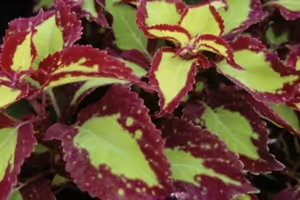
Coleus
Well known since Victorian times, Coleus (Solenostemon scutellarioides) has sparked a revival of sorts with the availability of numerous named cultivars. Coleus is available from seed as well as cutting grown cultivars offering an endless array of colors and patterns. Most seed coleus prefer shade to light shade with many of the new cutting types tolerant of full sun. Coleus grows from (12 inches to 3 feet tall) with habits ranging from mound shaped to spreading. It is a tender plant, not hardy in cold climates. Plants propagate easily from cuttings and make acceptable houseplants when given high light.
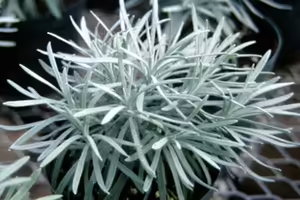
Licorice Plant
The Licorice plant (Helichrysm sp.) is used for its silvery-white foliage. Other cultivars within the species offer gold foliage and variegated green and white or green and yellow foliage. Plant habit ranges from a compact mound (8 to15 inches tall) to vigorous trailers that spread (24 to 36 inches). Plants prefer full sun and can tolerate dry conditions. Licorice plant is a tender annual.
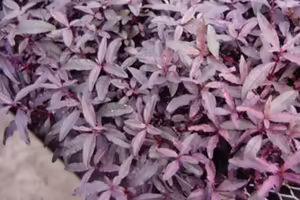
Calico plant
Calico plant (Alternanthera sp.) is an excellent filler plant used for its colorful foliage. Its habit ranges from compact mounds (6 to 12 inches tall) and low sprawling types to upright (2 to 3 feet) hedge forms. It grows best in full sun and is a tender plant that can be propagated easily from cuttings. Foliage color can range from reds to yellows to oranges and a variety of variegated forms.
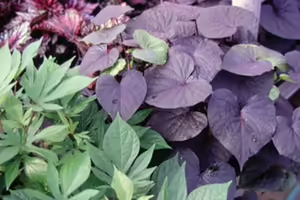
Sweet Potato
Ornamental sweet potatoes (Ipomoea batatas) are excellent ground covers, trailing (2 to 5 feet) across. Leaf color ranges from dark maroon to chartreuse. Most cultivars offer deeply cut foliage. Sweet potatoes do best in full sun. This is a tender plant that will not overwinter in cold climates. Sweet potatoes root easily and can be carried over the winter by digging and storing the tubers as you would dahlia tubers. New compact cultivars are available.

Mexican Mint
Mexican Mint(Plectranthus argentatus) is a member of the mint family offers excellent form and leaf color in addition to aroma. Leaf color can vary from silver-gray to green and white or green and yellow. Most have attractive scallop-edged leaves. Some cultivars have leaves with maroon undersides. Plants do best in full sun. Plant habit tends to be a mound growing up to 3 feet tall. An excellent trailing cultivar also exists. Mexican mint is a tender plant that roots easily and performs well as a houseplant.

Persian Shield
Persian shield(Stobilianthes dyeranus) produces silver and magenta leaves with a metallic sheen. Leaves often grow to 8 inches long on plants that grow upright to about 3 feet. Persian shield grows best in full sun to very light shade. Persian shield benefits from occasional pinching to keep it from getting leggy. This plant can be overwintered as a houseplant.
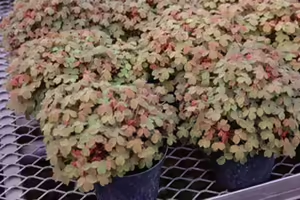
Sorrel
Sorrel(Oxails vulcanicola) is a unique shamrock leaved plant with brilliant copper foliage that looks like molten metal. Sorrel grows to about 6 inches tall in a neat mound and looks best when used in groups. It prefers full sun for best color and well-drained soil. Sorrel is a tender plant that is easily overwintered indoors.

Inch Plant
Inch plant(Setcreasea purpurea), a low growing plant (6 to 8 inches), is excellent as a ground cover. It produces a rich burgundy foliage that grows best in full sun. Tolerant of dry conditions, Inch plant is a tender plant that is easy to root and can be carried over the winter as a houseplant.

Blood leaf
Bloodleaf(Iresine sp.) is a plant that offers attractive, glossy foliage with clear red color or highly variegated with green and white. Plants grow to about (2 to 3 feet) and prefer light shade. Sometimes called "chicken gizzard." Bloodleaf is a tender plant that is easily grown from cuttings and overwinters well indoors.
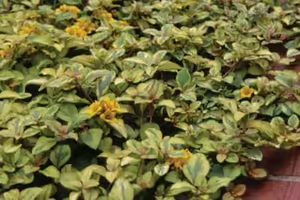
Creeping Jenny
With striking yellow green variegated foliage, creeping Jenny(Lysimachia congestifolia) grows in a spreading, trailing habit. Plants thrive best in full or partial shade.

Polka Dot Plant
Polka Dot Plant(Hypoestes phyllostachya) does well in full sun and moist, well drained soil growing to about 12 to 18 inches tall. It is best used in a mass planting. Hypoestes is easily grown from seed or cuttings. It can be cut back and overwintered as a houseplant. It is available in pink, white and red variegation.
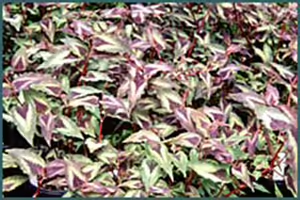
Tovara
This Tovara(Persicaria microcephala) prefers partial shade and moist soil. It grows to about (18 to 24 inches) tall and is useful as a ground cover or mass planting. It can sometimes be an aggressive grower.
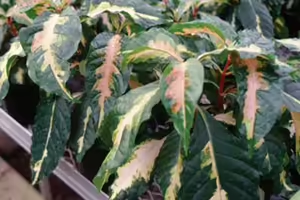
Caricature Plant
Caricature plant(Graptophyllum pictum) adapts well to heat, humidity, and full sun. It produces lush leathery foliage that is colored with green, white, and orange blotches as well as leaves that are dark mahogany. This tender plant grows to about 3 feet. It can be overwintered as a houseplant if given sufficient light.
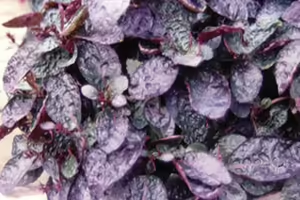
Waffle Plant
Waffle plant(Hemigraphis repanda) produces glossy, burgundy leaves that are wine red underneath. This plant has a spreading, mound shaped habit growing to about (12 to 15 inches) tall. Waffle plant grows well in warm conditions in shade to partial shade. It is a tender plant that overwinters well as a houseplant even under low light.
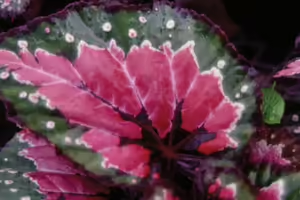
Rex Begonia
Rex begonias(Begonia rex-cultorum hyb.) are large-leaved and an extremely colorful group of plants. Many types are available offering a wide array of color markings and patterns. Plants grow 12 to 15 inches tall, forming mounds. Rex begonias grow best when planted in the shade in soil that is uniformly moist. They can be overwintered as a houseplant if given sufficient light.

Caladium
Caladium(Caladium bicolor) is a tender, tuberose-rooted perennial growing 8 inches to 3 feet tall. It produces excellent elephant-ear-like foliage in a variety of colors. Some varieties produce glossy, strap-like leaves. Caladium does best in the shade with the strap-like forms growing well in partial to full sun. Dig the tubers in the fall and store them in slightly damp peat or sawdust in an area no colder than 60 degrees.
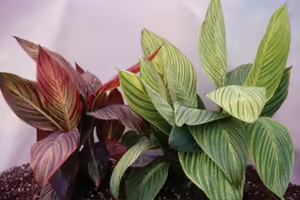
Canna Lily
Canna Lily(Cana x generalis) offers striking foliage on plants that grow from (3 to 14 feet) tall. Cannas prefer full sun and plenty of moisture. Almost any canna will grow in standing water if tubers are started in water. Dig the tubers in the fall after a light frost and store them in a cool area.

Elephant Ear
Elephant ears(Xanthosoma sp., Alocasia sp., Colocasia sp.) are a group of dramatic plants with large and colorful leaves. Colors range from chartreuse to almost black. Plants can achieve enormous size over the summer. Elephant ears thrive in a high organic matter soil with plenty of water in partial shade. Elephant ears enjoy weekly applications of liquid fertilizer to enhance their appearance. They are tender plants that need to be dug up in the fall. Store the tubers in a cool dry place.

Lavender Cotton
Lavender Cotton(Santolina chamaecyparissus) has excellent silver-gray foliage that has a musty odor. Grows best in full sun in very well drained soil. Plant grows to about 18 inches and is used as a specimen plant or can be trimmed to a compact temporary hedge. Santolina may be winter hardy with protection or can be overwintered indoors as a houseplant.
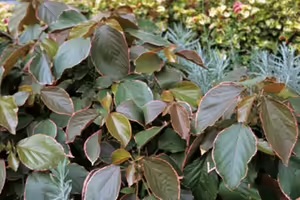
Copperleaf
Copperleaf(Acalypha wilkesiana) is a large, copper-colored oval foliage on plants that grow to about four feet tall. Prefers full sun and well-drained soil. Excellent specimen plant. Can be overwintered as a houseplant if given very high light.
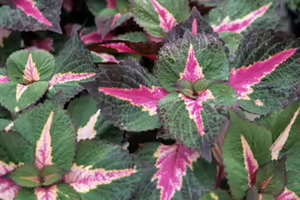
Perilla
Perilla(Perilla frutescens) are a great accent plane that resembles coleus. Grows to a height of (2 to 3 feet) prefers full sun. Good in containers and beds. Unlike coleus, perilla sends up less flower spikes that need to be deadheaded. This vegetatively propagated Perilla is not like its seed produced relatives and don’t reseed, becoming a garden problem.
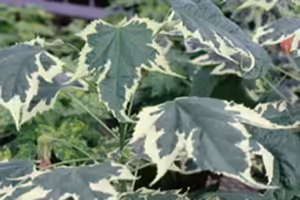
Flowering Maple
Flowering maple(Abutilon sp.) is a slender, weeping shrub that provides great foliage color and interest. The maple-like leaves are often variegated with yellow or white. Plants grow to (1 to 3 feet) tall. It will sometimes provide late fall color as it is tolerant of very light frosts. Flowering maple prefers full sun and a soil that stays evenly moist. Flowering maple is a tender plant that can be overwintered as a houseplant if given very high light.
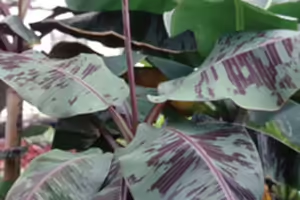
Banana
Many bananas(Musa sp.) can be grown as tender perennials in northern climates. Plants grow fast producing big and bold, often colorful leaves. Bananas do best in full to part sun in moist soil. Bananas can be overwintered by digging the root, cutting back the stem to about 6 inches, and storing like a canna. The Japanese Fiber Banana (M. basjoo) is one of the hardiest, being hardy down to 0°F when covered with ample mulch.
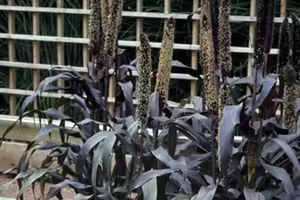
Ornamental Millet
The foliage of the Ornamental Millet(Pennisetum glaucum) is “corn-like” in appearance but offers colors from intense burgundy red to amber/purple mix. Plants grow (3 to 5 feet) tall and prefer full sun. Millet will produce cattail-like flowers stalks. When ripe, birds are often drawn to them to feed on the seeds. Plants are good as background plants, used in mass plantings and in containers when a tall focal point is needed.
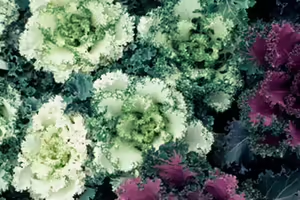
Ornamental Cabbage and Kale, Red Mustard
For great fall color to replace tired annuals, consider using ornamental cabbages and kales or red mustard(Brassica sp.). These are easily started from seed in late July and will be ready for fall planting in September. They enjoy the cool days of fall with color often intensifying as it gets cooler. Because they are frost tolerant, look for them to last well into fall and perhaps early winter it temperatures stay above 20 degrees.
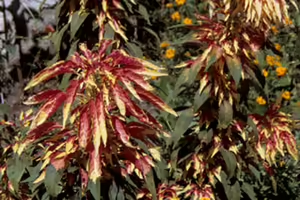
Amaranth, Summer Poinsettia
Amaranth, Summer Poinsettia(Amaranthus sp) is a full sun plant grows (3 to 6 feet) tall and produces the most intensely colored foliage. New growth can offer variegated color, bright yellows, deep fiery reds, and yellows depending on the cultivar chosen. Amaranth prefers high fertility and because of their prolific reseeding habit may become a garden “weed”. Plant carefully or be ruthless with the how the following spring.